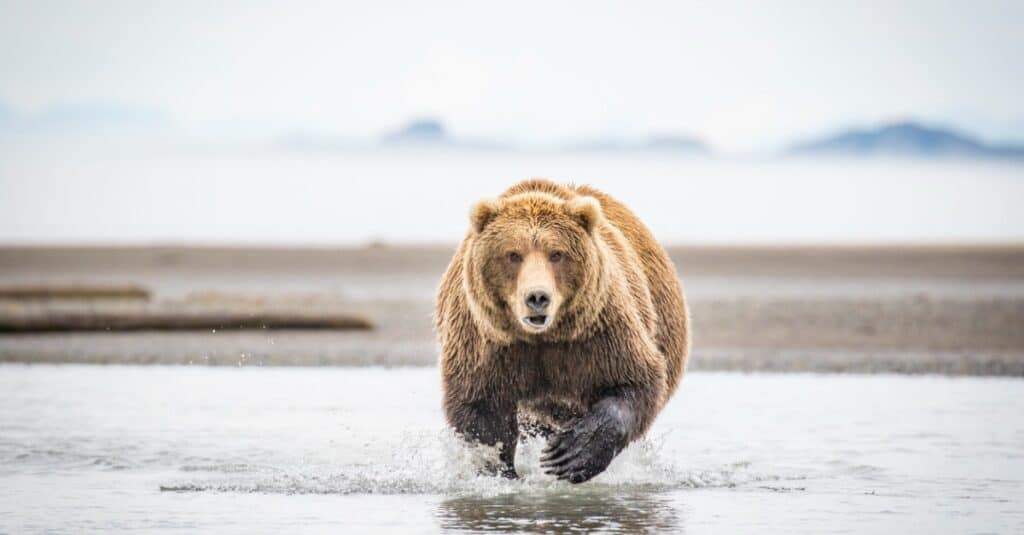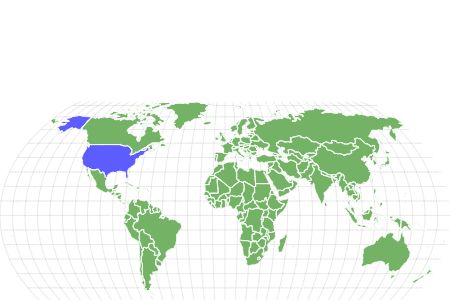Kodiak bears are the second largest bear in the world after the polar bear.
Advertisement
Kodiak Bear Scientific Classification
- Kingdom
- Animalia
- Phylum
- Chordata
- Class
- Mammalia
- Order
- Carnivora
- Family
- Ursidae
- Genus
- Ursus
- Scientific Name
- Ursus arctos middendorffi
Read our Complete Guide to Classification of Animals.
Kodiak Bear Conservation Status
Kodiak Bear Facts
- Prey
- Fish
- Main Prey
- Pacific salmon
- Name Of Young
- Cub
- Group Behavior
- Solitary
- Fun Fact
- Kodiak bears are the second largest bear in the world after the polar bear.
- Estimated Population Size
- Approximately 3,500
- Biggest Threat
- Inbreeding within the species
- Most Distinctive Feature
- Kodiak bears are the largest of the brown bears
- Other Name(s)
- Kodiak brown bear, Alaskan brown bear
- Gestation Period
- 180–270 days
- Temperament
- Mild
- Age Of Independence
- 3 years
- Litter Size
- 2 cubs
- Habitat
- Found exclusively on the islands of the Kodiak Archipelago
- Predators
- Humans; larger Kodiak bears may kill smaller, young bears
- Diet
- Omnivore
- Average Litter Size
- 2
- Lifestyle
- Diurnal/Nocturnal
- Favorite Food
- Vegetation, salmon, carrion
- Type
- Bear
- Common Name
- Kodiak Bear
- Number Of Species
- 1
- Location
- The islands of the Kodiak Archipelago
View all of the Kodiak Bear images!
Kodiak bears are the second largest in the world after the polar bear.
The Kodiak brown bear predominantly inhabits the islands of the Kodiak Archipelago in Southwest Alaska, USA, within the Kodiak National Wildlife Refuge. Kodiak Island is the largest in the US, covering almost 9,000 square kilometers (3,475 square miles).
Summary
The Kodiak brown bear, also known as the Alaskan brown bear, is one of the two largest bears in the world. Scientifically, they are Ursus arctos middendorffi. They live exclusively on the islands in the Kodiak Archipelago, and they have remained isolated for the last 12,000 years. Depending on what part of the archipelago they come from, their hair color often ranges from blonde to orange and dark brown. While the Kodiak bear has proven to be strong, healthy, and reproductive, it is vulnerable to parasites and diseases. They live longer than most species, with their standard lifespan ranging from 25 to 27 years.
Kodiak Bear Facts
- Kodiak bears are the largest brown bears in the world. Weighing up to 1,600 lbs, they’re also the second largest bear.
- There are approximately 3,500 Kodiak bears that inhabit the Kodiak archipelago.
- Kodiak archipelago are in isolation since the last ice age, which was about 10,000–20,000 years ago.
- Many think Kodiak Bears are carnivorous. They are, in reality, omnivorous.
- Despite their size, they are graceful swimmers.
Scientific Name
Commonly referred to as the Kodiak brown bear, its scientific name is Ursus arctos middendorffi. Ursus is Latin for bear. Arctos comes from the Greek word for bear. Their specific name is in honor of the celebrated Baltic naturalist, Dr. Alexander Theodor von Middendorff. It belongs to the Ursidae family, which existed since the mid-Miocene age, about 15-20 million years ago.
The Kodiak bear is a subspecies of brown bear and was first recognized by taxonomist C.H Merriam. Their common name is a reference to their native habitat, the islands of the Kodiak Archipelago located southwest of Alaska.
Appearance and Behavior

Kodiak bears live exclusively on the islands in the Kodiak Archipelago. This location is just below the arctic circle and has a subpolar climate.
©iStock.com/Jess Bray
Aside from their massive size, the Kodiak bear doesn’t differ greatly from other brown bears in terms of appearance. Thick furs cover their body that ranges from dark brown to blonde or orange. Females, alongside bears from the southern part of their range, are often dark brown. The cubs often have a white natal ring around their neck until they reach maturity. The overall coloring of their face differs from what is found on their bodies. This is what distinguishes them from grizzly bears. They have sharp claws and teeth. They do not have very good eyesight, but they make up for that deficiency with excellent hearing and a good sense of smell.
Kodiak bears are among the largest bears in the world—comparable only to polar bears. Males weigh between 600-1,400 lbs on average. Females are typically smaller, weighing between 400 and 700 lbs. While standing on their hind legs, male bears can surpass 9.8ft. However, they’re typically about 4.9ft tall on all fours with an average length of 8ft. Kodiak bears are largely solitary. Still, they know how to cooperate and collaborate when food is in one location.
They live in areas near other bears, but they usually do not remain in social groups. They define dominance using complex social cues. Different noises and body language are used to avoid fights. They typically do not defend territories but have home ranges they use annually. The wide variety of foods on the Kodiak Islands ensures that they have some of the smallest home ranges of all bear populations.
Kodiak bears eat a lot during the summer and live on fat reserves while hibernating during winter. They start entering their dens in late October. Pregnant sows are the first to go into the dens, and males go in last. Some males forgo denning, preferring to stay awake all winter.
As with other bear species, their daily behaviors depend on their proximity to the human population. Those that live closer to humans are mostly nocturnal, while bears in isolated areas are more active during the day.
Kodiak Bear — Habitat
Kodiak bears live exclusively on the islands in the Kodiak Archipelago. This location is just below the arctic circle and has a subpolar climate. The archipelago is close to the ocean and offers abundant food sources. They have been isolated from other bears for more than 10,000 years. The specific islands they live on include Uganik, Raspberry, Afognak, Sitkalidak, and Shuyak. On the islands, their habitats can range from dense forests to icy mountains. Some islands are characterized by hills, streams, and lakes, all of which the bears explore. Half of these islands are in the Kodiak Wildlife Refuge. Apart from a few zoos, you won’t find these subspecies anywhere else in the world.
Threats and Predators
The diet of the average Kodiak bear depends on factors like time, season, and food availability. When they emerge from their dens in the spring, most of their food is from recently matured vegetation like grasses, roots, seeds, and berries. In the summer, salmon provides a steady supply of high-calorie food, and they prefer the brains, flesh, and egg parts as a way of maximizing nutrition. The internal organs of deer, elk, and cattle are eaten first when killed or scavenged.
In recent times, since climate change now causes some berries to ripen earlier than expected, some of the Kodiak bear population now consume more berries than salmon due to large-scale availability. Fish is usually a large part of their diet, but few Kodiak bears take the time and effort to kill them. Although they have been dubbed the largest carnivores in the world, they are actually omnivores.
Kodiak bears are top predators due to their weight and size. This means they have very few natural predators. In terms of threats, there are strict regulations that have guided bear hunting for decades. Today, hunters kill about 180 bears annually under tight restrictions, with 70% of the bears being male. Habitat protection is done by the Alaska Department of Fish & Game and Kodiak Wildlife Refuge. Since 1941, the federal government has honored the request to protect Kodiak bears.
The main threats are climate change, energy development projects, associated road building, and the likelihood of an increase in conflicts. Kodiak bears are also more vulnerable to parasites and diseases as opposed to other bears. Scientists have attributed this to inbreeding within the species.
Kodiak Bear — Reproduction, Babies, and Lifespan
Kodiak bear mating season runs between May and June. They have elaborate mating rituals, which include foreplay. For foreplay, they rub, cuff, or even bite each other. The mechanical stimulation helps to stimulate ovulation in the female.
Sows (females) can start reproducing at the age of five and usually have one litter every four years. The gestation period lasts from 180 to 270 days. Cubs are usually born blind and toothless between December and March. Sows can often be seen with five or six cubs in tow because oftentimes, they adopt cubs from other litters. Most cubs stay with their mothers for three years before setting out on their own.
However, cannibalism by adult males causes a high level of mortality amongst cubs, especially amongst those away from their mothers. They are serial monogamists, and they usually stick to one mate at a time, which means there is less competition among males for mating rights. However, they usually have multiple partners throughout their lifespan. Once courting is over, the pair stays together for a couple of weeks. Kodiak bears engage in what is known as delayed implantation. When eggs are successfully fertilized, the embryo is not attached to the uterus right away. By doing this, the birth of the cubs coincides with their hibernation.
The average litter size is about 2-3 cubs, while the average cub weighs around one pound at birth and relies solely on its mother for nursing. The mothers nurse the cubs until April or May when hibernation ends. The average lifespan for a male is 25. Sows can produce cubs throughout their lives, but their fertility begins to decline around age 20, and few live longer than a few years after that. The oldest known male lived for 27 years, while the oldest known female lived for 35 years.
Kodiak Bear — Population
Approximately 3,500 bears inhabit the Kodiak Archipelago, with a density of 0.7 bears per square mile. Their number has been slowly increasing over the years, but cannibalism and slow reproduction are contributing factors hindering population growth. Currently, the Kodiak bear population is healthy and productive. Given their stable population, they’re classified to be of Lower Risk or Least Concern.
Related Animals
View all 77 animals that start with KKodiak Bear FAQs (Frequently Asked Questions)
Why are Kodiak bears so big?
The habitat of Kodiak bears ensures that they have enough food and less competition and predators. They also have a greater bone structure.
Are Kodiak bears friendly?
Kodiak bears are not aggressive, and they tend to avoid humans as much as possible. If anyone wanders too close, they usually do not hesitate to attack or kill. It is best to keep a healthy distance.
Is the Kodiak bear bigger than the polar bear?
Both are almost equivalent in size, but polar bears slightly outweigh Kodiak bears.
Thank you for reading! Have some feedback for us? Contact the AZ Animals editorial team.
Sources
- Britannica, Available here: https://www.britannica.com/animal/Kodiak-bear
- Animalia, Available here: https://animalia.bio/kodiak-bear
- Alaska Department of Fish and Game , Available here: https://www.adfg.alaska.gov/index.cfm?adfg=kodiakbearplan.summary
- Biology Dictionary / Shawn Laidlaw, Available here: https://biologydictionary.net/kodiak-bear/

















